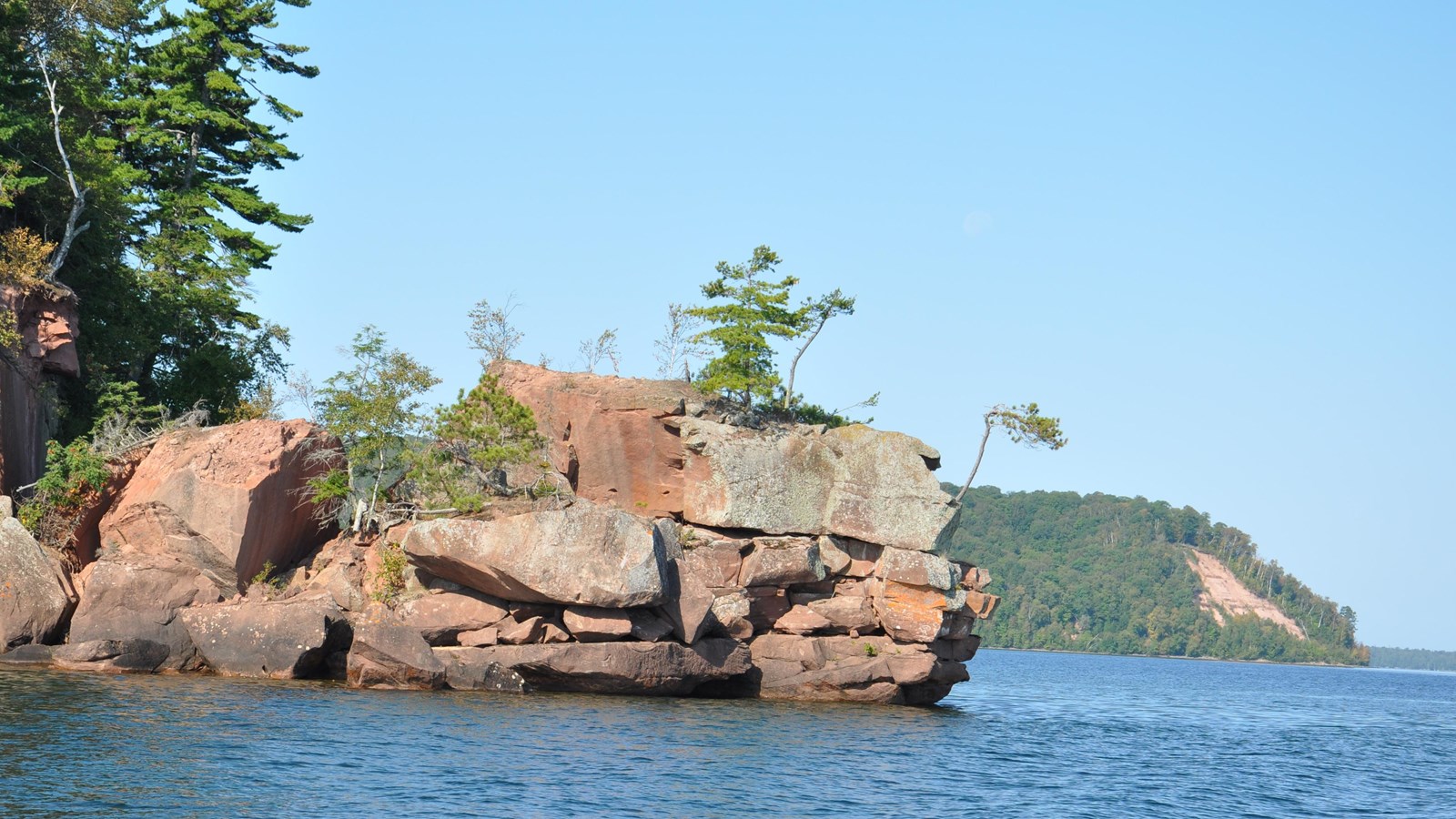Last updated: November 7, 2021
Place
Oak Island

NPS Photo/ Neil Howk
Animal-Safe Food Storage, Beach/Water Access, Dock/Pier, Information Kiosk/Bulletin Board, Toilet - Vault/Composting, Trailhead
Oak Island Mitigominikaani-minis, is 5,078 acres with 12 miles of shoreline and 11.5 miles of maintained hiking trails. Off-trail hiking can be treacherous and is unadvised. A diverse habitat of sandstone ledges, sandy beachs, and rocky bluffs creates a variety of activities and ecosytems to explore on Oak Island.
Camping, Hunting, and Boating
Camping permits are required for all camping in the national lakeshore. A nightly fee is charged for camping in the park and all the permits can be made on recreation.gov. Oak has five individual sites and two group campsites. Campsites may occasionally be closed due to bear activity or to preserve sensitive resources.
Deer hunting is allowed on all islands in the national lakeshore. Hunters must pay for a hunter access permit. An archery hunt is offered from September 13 - 30 and from November 1 - December 31. A muzzle loader hunt is conducted during October. Contact the park’s chief of protection for details.
A wooden dock is located in the middle of the west side of the island. Maximum water depth at the end of this dock varies but is usually about six feet. Docking is permitted as space allows. A fee is charged for overnight docking. Dock space may be reserved at certain times for excursion boats. Oak Island provides several possible anchorage areas, depending on wind conditions. Boaters are encouraged to monitor marine weather forecasts.
Leave No Trace
Almost all of Oak Island is now included in Apostle Islands National Lakeshore’s 33,500-acre Gaylord Nelson Wilderness. Visitors must do their part to help preserve the island’s wild and primitive character. Please follow the seven principles of Leave No Trace outdoor ethics. Beaches are some of the parks most popular attractions. They also support fragile plant communities. Please walk near the water line or on established trails and take care not to trample beach grasses and lichen. Please camp only on durable surfaces like sand, rock, or leaf litter. Where vault toilets are not available for human waste, dig a hole 6-8 inches deep and 200 feet from camp and the nearest body of water. Cover the hole after use. Campfires must be built in fire receptacles where provided. Dead wood on the ground in forested areas or on unvegetated beaches may be collected for firewood. Do not carry firewood into or between islands in the park. Be prepared to pack out whatever you pack in. Do not remove any artifacts from the islands in the park. These leave no trace principles are caring activities designed to decrease the negative effects that users have on the environment.
Bear habitat
Oak Islands proximity to the mainland makes it an easy swim for bears looking for a new territory. Bears and bear signs are frequently seen by island visitors. Improperly stored food continues to lure bears to the island campsites. Visitors must take precautions to help keep this from happening. Never approach or feed a bear. Keep a distance of at least 50 yards, even for photography. Don’t lure or allow bears to feel comfortable around campsites, docks, and picnic areas. Store food and garbage in the bear proof lockers provided at campsites. If you encounter a bear in a visitor use area; make yourself look big, bang pots, yell, make noise until the bear leaves the area, and report the encounter to park staff as soon as possible.
Ojibwe Lumberjacks, and the “King”
Native people have camped and harvested food on Oak Island for centuries. Nineteenth century land surveys note the location of a maple “sugar bush” on the island used by the Ojibwe. In the 1850’s, Benjamin Armstrong from Alabama built a cabin on the island and lived there for about six years. He learned the Ojibwe language and served as a translator and advisor to tribal elders, accompanying them to Washington DC to meet with presidents Fillmore and Lincoln. As early as the 1850s, a cordwood business was flourishing here, supplying fuel to passing steamships. The island was subsequently logged for pine in the 1880’s and 1890’s, and for hemlock and hardwoods throughout the 1920’s. As many as six lumber camps including those of the Schroeder and R.D. Pike Lumber Companies, once dotted the shores of Oak Island. Some of the clearings and remnants of these camps are still evident today. During and after the Great Depression, commercial fisherman used parts of the islands as base camps. One of these men, Martin Kane, took up permanent residence in an old lumber camp shack near the sand spit, where he lived for over 25 years as the friendly “king” of Oak Island. Martin made his living fishing with gill nets and set lines. He sold the whitefish and lake trout that he caught to the Booth Company in Bayfield. A 1946 article from the Ashland Daily Press explained that the shack where Martin Kane lived with two dogs and a cat had a bed, a table, one chair, and a stove. Sparks from the stove ignited a fire that burned about 4,000 acres of the island in October 1943.
